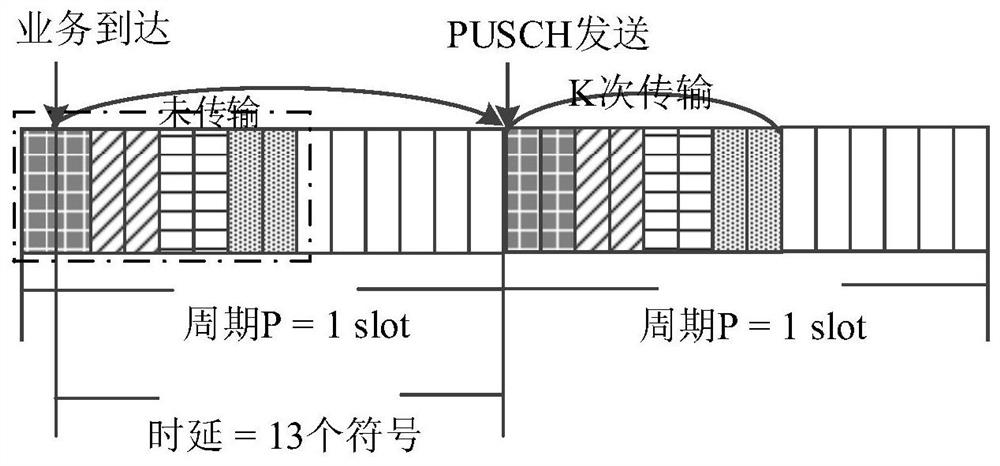Semi-persistent scheduling method, base station equipment and user equipment
A semi-static scheduling, user equipment technology, applied in the directions of multiple use of transmission paths, transmission modification based on link quality, and payload allocation, etc., can solve problems such as difficulty in supporting URLLC requirements of multiple services
- Summary
- Abstract
- Description
- Claims
- Application Information
AI Technical Summary
Problems solved by technology
Method used
Image
Examples
Embodiment 1
[0183] In the prior art, for the first type of SPS / CG transmission, if semi-persistent scheduling parameters need to be changed, the base station needs to send high-level signaling to reconfigure all semi-persistent scheduling parameters. For example, for uplink CG PUSCH transmission, the high-level signaling rrc-ConfiguredUplinkGrant information includes time resources, frequency domain resources, antenna port information, reference signal DMRS signal, MIMO related information, modulation and coding information (MCS and TBS), and power control information, etc. . Generally, the time delay for reconfiguration through high-level RRC signaling is relatively large. If the first type of SPS / CG transmission needs to feedback HARQ-ACK to confirm HARQ-ACK, high-layer signaling also needs to configure parameters related to HARQ-ACK feedback, such as HARQ-ACK feedback time information and PUCCH resource information.
[0184]
[0185] In order to change semi-persistent scheduling pa...
Embodiment 2
[0195]In some scenarios, such as supporting different service types, the parameters of multiple sets of SPS / CG configurations are different. In other scenarios, multiple sets of SPS / CG configurations have similar or identical characteristics, so a set of signaling can be used to configure the same / common transmission parameters in these SPS / CG configurations. For example, in order to reduce delay, multiple sets of SPS / CG configuration can be configured for the same URLLC service type. For another example, in order to solve the problem that the period of the time-sensitive service (TSN) is not an integral multiple of the period of the SPS / CG configuration, multiple sets of SPS / CG configurations can be configured for the same TSN service. The multiple sets of SPS / CG configurations have the same frequency domain resource, modulation and coding information, and period, but the starting positions of the time domain are different. For example, there is a time offset between the PDSC...
Embodiment 3
[0226]The configuration signaling of time resources described above, the start symbol and symbol length of SPS / CG PDSCH / PUSCH can reuse the start symbol and symbol in the time resource allocation table (such as PUSCH-TimeDomainResourceAllocation) configured by the base station for scheduling-based PDSCH / PUSCH Length, the time offset between SPS / CG PDSCH / PUSCH and the offset of the first / first set of SPS / CG PDSCH / PUSCH relative to SFN 0 or relative to the time slot where SPS / CG activation signaling is located / The offset of the sub-slot is indicated separately, and the two time offsets can be indicated in independent fields, or can be coded jointly. Another implementation, the starting symbol and symbol length of SPS / CG PDSCH / PUSCH, and the time offset between SPS / CG PDSCH / PUSCH are jointly coded to form a new time resource allocation table dedicated to SPS / CG PDSCH / PUSCH. Or, the starting symbol and symbol length of SPS / CG PDSCH / PUSCH, the time offset between SPS / CG PDSCH / PU...
PUM
 Login to View More
Login to View More Abstract
Description
Claims
Application Information
 Login to View More
Login to View More - R&D
- Intellectual Property
- Life Sciences
- Materials
- Tech Scout
- Unparalleled Data Quality
- Higher Quality Content
- 60% Fewer Hallucinations
Browse by: Latest US Patents, China's latest patents, Technical Efficacy Thesaurus, Application Domain, Technology Topic, Popular Technical Reports.
© 2025 PatSnap. All rights reserved.Legal|Privacy policy|Modern Slavery Act Transparency Statement|Sitemap|About US| Contact US: help@patsnap.com



